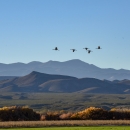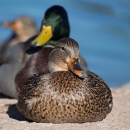States
AlaskaEcosystem
WetlandOverview
Mallard banding in Alaska is one component in setting hunting regulations for the species along the Pacific Flyway. Western mallards of the Pacific Flyway consist of birds that breed in Alaska, or those that breed in the southern Pacific Flyway (California, Oregon, Washington, and British Columbia). The current banding goals for mallards in Alaska is 1,000 adult males, 1,000 adult females, 2,000 juvenile males and 2,000 juvenile females. These goals can only be achieved if the effort is spread across the state and among partners. Mallards are banded in multiple locations in Alaska, and throughout North America to inform management of the species. In Alaska, Mallards are banded on state game refuges (SGRs) and national wildlife refuges (NWRs), including Minto Flats SGR (Alaska Department of Fish and Game [ADFG]), Palmer Hay Flats SGR (USFWS MBM and USDA APHIS), Tetlin NWR (USFWS Refuges), Koyukuk-Nowitna NWR (USFWS Refuges), Yukon Flats (USFWS Refuges), and Yukon Delta NWR (USFWS Refuges).
The banding data collected during this project and throughout Alaska is analyzed by the USFWS Migratory Bird Program at Headquarters and used to inform the harvest strategy for the species across North America. The Waterfowl Section of USFWS Alaska Migratory Bird Program contributes to the harvest management strategy by conducting Mallard banding at Duck Lake in Palmer Hay Flats SGR, alongside our partner USDA-APHIS Wildlife Services, who do avian influenza (AI) surveillance at Duck Lake in addition to banding waterfowl.
Importance of this Work
Duck banding in North America is a large-scale partnership between the USFWS, Canadian Wildlife Services, and U.S. state wildlife agencies. It takes a coordinated, yearly effort to successfully manage the species. The USFWS directly manages Mallards by conducting aerial surveys and banding birds throughout North America. Banding and aerial counts are integral tools in determining a regularly strategy (liberal, moderate, restrictive, or closed), or harvest limits for a hunted species. Bird banding can also be used to understand migration routes, survival, and population size.
Actions WE ALL can take
Adhering to harvest limits and hunting regulations. Stewardship of our harvested species takes all of us. Making sure you follow the annual harvest limits set by biologists is critical to make sure hunting isn’t negatively impacting a species’ population. By setting and following sustainable harvest, we can ensure that hunting is not an additional stressor to the Mallard population. Harvest limits are a controlled way to prevent overexploitation of a species and ensure hunting remains a balanced activity alongside other efforts addressing threats Mallard face.
Read more about our waterfowl banding operations in Southcentral Alaska in 2023
Read more about our waterfowl banding operation in Southcentral Alaska 2024
The Significance of Waterfowl Bands to Hunters and Scientists Alike


